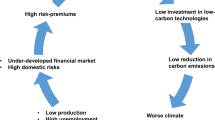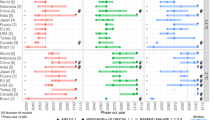Abstract
Reaching a pathway towards net zero GHG emissions requires rapid and massive investments in low-carbon infrastructure. To redirect finance flows accordingly, particularly the European Union places an emphasis on sustainable finance regulation. However, the specific investment shifts required are not fully understood, which could lead to an insufficient steering effect for crucial technologies. Here we conduct a meta-analysis to derive the required technology-level investment shifts for climate-relevant infrastructure until 2035. We find a steep uptick in overall investment need, with almost €90 billion yr−1 being required already within the very near term (2021–25). Investment shifts are most drastic for power plants, electricity grids and rail infrastructure, which is even increased by the ambitions to become independent from Russian gas imports. Our findings highlight the need for sustainable finance policies that take into account the financing structures of these sectors specifically.
This is a preview of subscription content, access via your institution
Access options
Access Nature and 54 other Nature Portfolio journals
Get Nature+, our best-value online-access subscription
$29.99 / 30 days
cancel any time
Subscribe to this journal
Receive 12 print issues and online access
$209.00 per year
only $17.42 per issue
Buy this article
- Purchase on Springer Link
- Instant access to full article PDF
Prices may be subject to local taxes which are calculated during checkout






Similar content being viewed by others
Data availability
All data generated or analysed during this study are included in the article and its Supplementary Information and Data files. Source data are provided with this paper.
Code availability
The code necessary to reproduce the six main figures and the t-test presented in the Supplementary Information is available at Zenodo65 under the identifier https://doi.org/10.5281/zenodo.7265457.
References
World Energy Outlook 2021 (IEA, 2021); https://iea.blob.core.windows.net/assets/ed3b983c-e2c9-401c-8633-749c3fefb375/WorldEnergyOutlook2021.pdf
Granoff, I., Hogarth, J. R. & Miller, A. Nested barriers to low-carbon infrastructure investment. Nat. Clim. Change 6, 1065–1071 (2016).
IPCC. Special Report on Global Warming of 1.5 °C (eds Masson-Delmotte, V. et al.) (WMO, 2018).
Steffen, B. A comparative analysis of green financial policy output in OECD countries. Environ. Res. Lett. 16, 074031 (2021).
Renewed Sustainable Finance Strategy and Implementation of the Action Plan on Financing Sustainable Growth (European Commission, 2018); https://ec.europa.eu/info/publications/sustainable-finance-renewed-strategy_en
2050 Long-term Strategy (European Commission, 2019); https://ec.europa.eu/clima/eu-action/climate-strategies-targets/2050-long-term-strategy_en
Long-term Climate Strategy to 2050 (Federal Office for the Environment, 2021); https://www.bafu.admin.ch/bafu/en/home/topics/climate/info-specialists/emission-reduction/reduction-targets/2050-target/climate-strategy-2050.html
Act Relating to Norway’s Climate Targets (Climate Change Act) (Ministry of Climate and Environment, 2021); https://lovdata.no/dokument/NLE/lov/2017-06-16-60
UK Enshrines New Target in Law to Slash Emissions by 78% by 2035 (Department for Business, Energy & Industrial Strategy & Prime Minister’s Office, 2021); https://www.gov.uk/government/news/uk-enshrines-new-target-in-law-to-slash-emissions-by-78-by-2035
Net Zero by 2050. A Roadmap for the Global Energy Sector (IEA, 2021); https://iea.blob.core.windows.net/assets/deebef5d-0c34-4539-9d0c-10b13d840027/NetZeroby2050-ARoadmapfortheGlobalEnergySector_CORR.pdf
Andrijevic, M., Schleussner, C.-F., Gidden, M. J., McCollum, D. L. & Rogelj, J. COVID-19 recovery funds dwarf clean energy investment needs. Science 370, 298–300 (2020).
McCollum, D. L. et al. Energy investment needs for fulfilling the Paris Agreement and achieving the Sustainable Development Goals. Nat. Energy 3, 589–599 (2018).
Pietzcker, R. C., Osorio, S. & Rodrigues, R. Tightening EU ETS targets in line with the European Green Deal: impacts on the decarbonization of the EU power sector. Appl. Energy 293, 116914 (2021).
Bogdanov, D. et al. Radical transformation pathway towards sustainable electricity via evolutionary steps. Nat. Commun. 10, 1077 (2019).
Polzin, F., Sanders, M. & Serebriakova, A. Finance in global transition scenarios: mapping investments by technology into finance needs by source. Energy Econ. 99, 105281 (2021).
Recharge EU: How Many Charge Points Will Europe and its Member States Need in the 2020s (Transport & Environment, 2020); https://www.transportenvironment.org/wp-content/uploads/2021/07/01%202020%20Draft%20TE%20Infrastructure%20Report%20Final.pdf
Persson, U., Wiechers, E., Möller, B. & Werner, S. Heat Roadmap Europe: heat distribution costs. Energy 176, 604–622 (2019).
Hof, A. F. et al. From global to national scenarios: bridging different models to explore power generation decarbonisation based on insights from socio-technical transition case studies. Technol. Forecast. Soc. Change 151, 119882 (2020).
Lux, B. & Pfluger, B. A supply curve of electricity-based hydrogen in a decarbonized European energy system in 2050. Appl. Energy 269, 115011 (2020).
Bogdanov, D. et al. Low-cost renewable electricity as the key driver of the global energy transition towards sustainability. Energy 227, 120467 (2021).
Field, A. P. & Gillett, R. How to do a meta-analysis. Br. J. Math. Stat. Psychol. 63, 665–694 (2010).
Gurevitch, J., Koricheva, J., Nakagawa, S. & Stewart, G. Meta-analysis and the science of research synthesis. Nature 555, 175–182 (2018).
Child, M., Kemfert, C., Bogdanov, D. & Breyer, C. Flexible electricity generation, grid exchange and storage for the transition to a 100% renewable energy system in Europe. Renew. Energy 139, 80–101 (2019).
Stolz, B., Held, M., Georges, G. & Boulouchos, K. Techno-economic analysis of renewable fuels for ships carrying bulk cargo in Europe. Nat. Energy 7, 203–212 (2022).
Griffiths, S., Sovacool, B. K., Kim, J., Bazilian, M. & Uratani, J. M. Industrial decarbonization via hydrogen: a critical and systematic review of developments, socio-technical systems and policy options. Energy Res. Soc. Sci. 80, 102208 (2021).
Markard, J. The next phase of the energy transition and its implications for research and policy. Nat. Energy 3, 628–633 (2018).
Breyer, C., Fasihi, M., Bajamundi, C. & Creutzig, F. Direct air capture of CO2: a key technology for ambitious climate change mitigation. Joule 3, 2053–2057 (2019).
van Vuuren, D. P. et al. Alternative pathways to the 1.5 °C target reduce the need for negative emission technologies. Nat. Clim. Change 8, 391–397 (2018).
Pastori, E. et al. Research for TRAN Committee—Modal Shift in European Transport: A Way Forward (European Parliament, 2018); https://op.europa.eu/en/publication-detail/-/publication/dbe95c09-1317-11e9-81b4-01aa75ed71a1/language-en
Sustainable and Smart Mobility Strategy—Putting European Transport on Track for the Future (European Commission, 2020); https://eur-lex.europa.eu/resource.html?uri=cellar:5e601657-3b06-11eb-b27b-01aa75ed71a1.0001.02/DOC_1&format=PDF
European Commission. Sustainable and Smart Mobility Strategy – putting European transport on track for the future. Available at https://eur-lex.europa.eu/resource.html?uri=cellar:5e601657-3b06-11eb-b27b-01aa75ed71a1.0001.02/DOC_1&format=PDF (2020).
Haegel, N. M. et al. Terawatt-scale photovoltaics: transform global energy. Science 364, 836–838 (2019).
Victoria, M. et al. Solar photovoltaics is ready to power a sustainable future. Joule 5, 1041–1056 (2021).
Renewable Capacity Statistics 2021 (IRENA, 2021); https://www.irena.org/publications/2021/March/Renewable-Capacity-Statistics-2021
Transporting Pure Hydrogen by Repurposing Existing Gas Infrastructure: Overview of Existing Studies and Reflections on the Conditions for Repurposing (European Union Agency for the Cooperation of Energy Regulators, 2021).
Steffen, B. & Patt, A. A historical turning point? Early evidence on how the Russia–Ukraine war changes public support for clean energy policies. Energy Res. Soc. Sci. 91, 102758 (2022).
Lau, M., Ricks, W., Patankar, N. & Jenkins, J. Pathways to European independence from Russian natural gas. Zenodo https://zenodo.org/record/6917456#.Y1a0CnZBw-U (2022).
Pedersen, T. T., Gøtske, E. K., Dvorak, A., Andresen, G. B. & Victoria, M. Long-term implications of reduced gas imports on the decarbonization of the European energy system. Joule 6, 1566–1580 (2022).
Does Phasing-out Russian Gas Require New Gas Infrastructure? (Artelys, 2022); https://www.artelys.com/wp-content/uploads/2022/05/Artelys-Russian-gas-phase-out-Briefing-note.pdf
EU’s Russian Gas Phase-Out Hinges on Clean Energy (Bloomberg, 2022).
Financing REPowerEU (European Commission, 2022); https://ec.europa.eu/commission/presscorner/detail/en/fs_22_3135
Steffen, B. The importance of project finance for renewable energy projects. Energy Econ. 69, 280–294 (2018).
Henderson, M. in The Principles of Project Finance (ed. Morisson, R.) 185–204 (Routledge, 2016).
Global Trends in Renewable Energy Investment 2020 (Frankfurt School-UNEP Centre & BNEF, 2020); https://www.fs-unep-centre.org/wp-content/uploads/2020/06/GTR_2020.pdf
Report on Regulatory Frameworks for European Energy Networks 2020 (Council of European Energy Regulators, 2021); https://www.ceer.eu/documents/104400/-/-/5947b3af-5643-1411-02c9-b5d009b7b748
The Regulatory Asset Base and Project Finance Models. An Analysis of Incentives for Efficiency (OECD, 2016); https://www.itf-oecd.org/sites/default/files/dp_2016-01_makovsek_and_veryard.pdf
Ameli, N., Kothari, S. & Grubb, M. Misplaced expectations from climate disclosure initiatives. Nat. Clim. Change 11, 917–924 (2021).
Mazzucato, M. & Semieniuk, G. Financing renewable energy: who is financing what and why it matters. Technol. Forecast. Soc. Change 127, 8–22 (2018).
The European Green Deal Investment Plan and Just Transition Mechanism Explained (European Commission, 2020); https://ec.europa.eu/commission/presscorner/detail/en/qanda_20_24
>€1 Trillion for <1.5 °C. Climate and Environmental Ambitions of the European Investment Bank Group (European Investment Bank, 2020); https://www.eib.org/attachments/thematic/eib_group_climate_and_environmental_ambitions_en.pdf
Climate Action and Environmental Sustainability: Overview 2021 (European Investment Bank, 2021); https://www.eib.org/attachments/thematic/climate_action_and_enviromental_sustainability_overview_2021_en.pdf
Climate Action and Environmental Sustainability: Overview 2022 (European Investment Bank, 2022); https://www.eib.org/attachments/publications/climate_action_and_enviromental_sustainability_overview_2022_en.pdf
Climate Action and Environmental Sustainability: Overview 2020 (European Investment Bank, 2020); https://www.eib.org/attachments/thematic/climate_action_and_enviromental_sustainability_overview_2020_en.pdf
Steffen, B. & Schmidt, T. S. A quantitative analysis of 10 multilateral development banks’ investment in conventional and renewable power-generation technologies from 2006 to 2015. Nat. Energy 4, 75–82 (2019).
EIB Group Climate Bank Roadmap 2021–2025 (European Investment Bank, 2020); https://www.eib.org/attachments/thematic/eib_group_climate_bank_roadmap_en.pdf
Geddes, A., Schmidt, T. S. & Steffen, B. The multiple roles of state investment banks in low-carbon energy finance: an analysis of Australia, the UK and Germany. Energy Policy 115, 158–170 (2018).
Egli, F., Steffen, B. & Schmidt, T. S. A dynamic analysis of financing conditions for renewable energy technologies. Nat. Energy 3, 1084–1092 (2018).
Kempa, K., Moslener, U. & Schenker, O. The cost of debt of renewable and non-renewable energy firms. Nat. Energy 6, 135–142 (2021).
Riahi, K. et al. Cost and attainability of meeting stringent climate targets without overshoot. Nat. Clim. Change 11, 1063–1069 (2021).
Seto, K. C. et al. Carbon lock-in: types, causes, and policy implications. Annu. Rev. Environ. Resour. 41, 425–452 (2016).
Technical Note on Estimates of Infrastructure Investment Needs. Background Note to the Report Investing in Climate, Investing in Growth (OECD, 2017); https://www.oecd.org/env/cc/g20-climate/Technical-note-estimates-of-infrastructure-investment-needs.pdf
Scopus. Expertly Curated Abstract & Citation Database (Elsevier, 2022); https://www.elsevier.com/solutions/scopus
EU Action (European Commission, 2021); https://ec.europa.eu/clima/eu-action_en
Tapio, P. Towards a theory of decoupling: degrees of decoupling in the EU and the case of road traffic in Finland between 1970 and 2001. Transp. Policy 12, 137–151 (2005).
Klaaßen, L. & Steffen, B. Meta-analysis on necessary investment shifts to reach net zero pathways in Europe. Zenodo https://doi.org/10.5281/zenodo.7265457 (2022).
Acknowledgements
L.K. and B.S. have received funding from the EU Horizon 2020 research and innovation programme, European Research Council (grant agreement no. 948220, project no. GREENFIN) for this project. The compilation of the database and the plotting of the results were supported by F. Hafner, N. Knecht, G. Mancini and M. Prébandier.
Author information
Authors and Affiliations
Contributions
B.S. and L.K. developed the research idea. L.K. compiled and analysed the data. L.K. and B.S. interpreted the results and wrote the paper. B.S. secured project funding.
Corresponding authors
Ethics declarations
Competing interests
The authors declare no competing interests.
Peer review
Peer review information
Nature Climate Change thanks Johannes Schmidt, Kyle Herman and the other, anonymous, reviewer(s) for their contribution to the peer review of this work.
Additional information
Publisher’s note Springer Nature remains neutral with regard to jurisdictional claims in published maps and institutional affiliations.
Supplementary information
Supplementary Information
Supplementary Text, Figs. 1–12, Tables 1–10 and refs. 1–71.
Supplementary Data 1
Literature overview; Data analysis; Extended analysis—Russian gas phase out.
Supplementary Data 2
PRISMA checklist.
Source data
Source Data Fig. 1
Statistical source data.
Source Data Fig. 2
Statistical source data.
Source Data Fig. 3
Statistical source data.
Source Data Fig. 4
Statistical source data.
Source Data Fig. 5
Statistical source data.
Source Data Fig. 6
Statistical source data.
Rights and permissions
Springer Nature or its licensor (e.g. a society or other partner) holds exclusive rights to this article under a publishing agreement with the author(s) or other rightsholder(s); author self-archiving of the accepted manuscript version of this article is solely governed by the terms of such publishing agreement and applicable law.
About this article
Cite this article
Klaaßen, L., Steffen, B. Meta-analysis on necessary investment shifts to reach net zero pathways in Europe. Nat. Clim. Chang. 13, 58–66 (2023). https://doi.org/10.1038/s41558-022-01549-5
Received:
Accepted:
Published:
Issue Date:
DOI: https://doi.org/10.1038/s41558-022-01549-5
This article is cited by
-
Cities and regions tackle climate change mitigation but often focus on less effective solutions
Communications Earth & Environment (2023)
-
Accelerating the energy transition towards photovoltaic and wind in China
Nature (2023)



